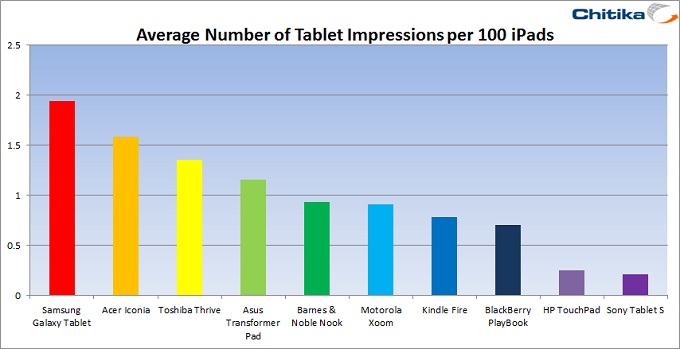Since its release in 2010, Apple’s iPad has made a name for itself as the standard in tablet computing. Competing manufacturers, though, have not given up on improving their shares of tablet web traffic. While manufacturers strive to become competitive with lighter devices, improved resolution, and other features, there is yet to emerge any serious competitor to the iPad. With more tablets entering the market every week, we wanted to update to our tablet study from early May with the latest data.
To quantify this study, Chitika Insights took a sample composed of hundreds of millions of impressions from the Chitika Ad network; ranging from June 4 to June 10, 2012. A user agent analysis was then conducted on this sample of data to determine the distribution of impressions across devices classified as tablets. The data was then relayed in accordance to the average number of devices per 100 iPads. A table depicting the results of this study can be seen below:
We found that 91.07% of tablet web traffic comes from iPad devices. While the iPad still accounts for a great majority of tablet web traffic, it has fallen about 3.5% from the 94.64% figure we reported in early May. The rise in use of non-iPad tablets is likely an effect of the increased options for consumers (hundreds of models are available), in addition to declining tablet prices. Among non-iPad tablets, the Samsung Galaxy leads the pack with 1.77% of tablet web traffic and 1.94 devices per 100 iPads. Other tablets performing particularly well include the Acer Iconia, Toshiba Thrive and Asus Transformer Pad.
Aside from iPad share, a significant finding from this study is that the Barnes & Noble Nook has overtaken the Kindle Fire in web traffic impressions. Compared to our previous study of tablets per 100 iPads, the Kindle has maintained its share while the Nook has gained. Barnes & Nobles’ e-reader with tablet capabilities now accounts for 0.85% of all tablet web traffic versus Kindle Fire’s .71%. In the time since that study, Barnes & Noble has launched a new advertising campaign, and their newest device sold out within weeks. While that device is a simple e-reader without web browsing capabilities, the increase in Nook use may be attributed to brand familiarity through these advertisements.
As future tablets are released onto the market, we may expect to see the iPad’s share drop to levels more comparable to its overall mobile device share. With Windows 8 tablets expected in the fourth quarter, the future of tablet web traffic will certainly be interesting to observe.
Without a doubt, the tablet market has become a real and significant source of web traffic, and developers must be sure their sites are formatted across all operating systems. Outside of web traffic, applications running on tablets present a huge opportunity for advertisers to reach their desired market.

102 comments